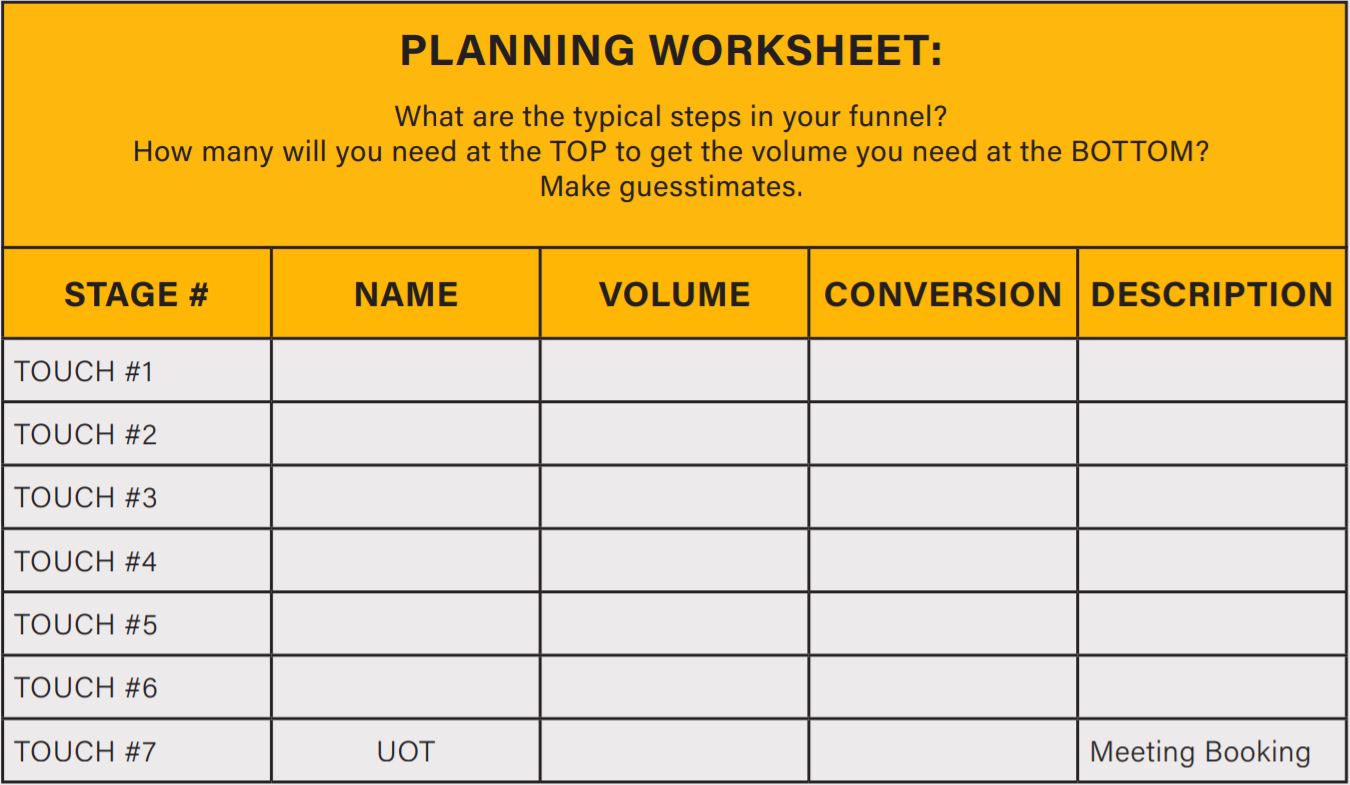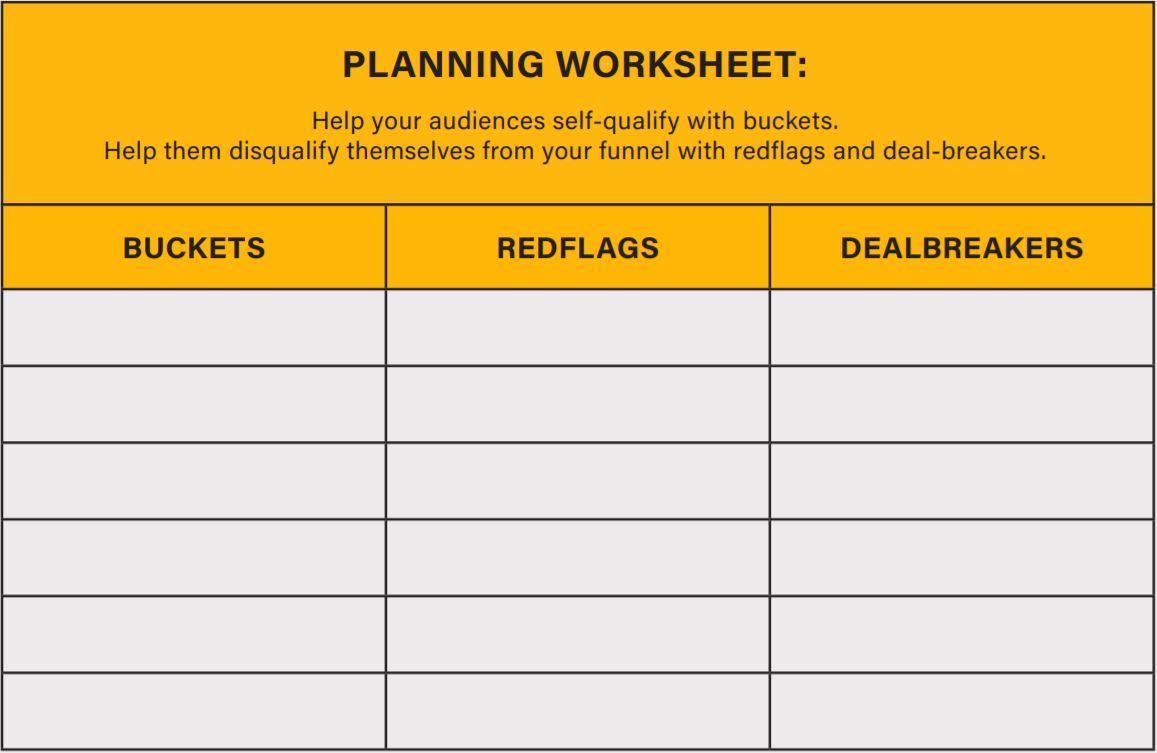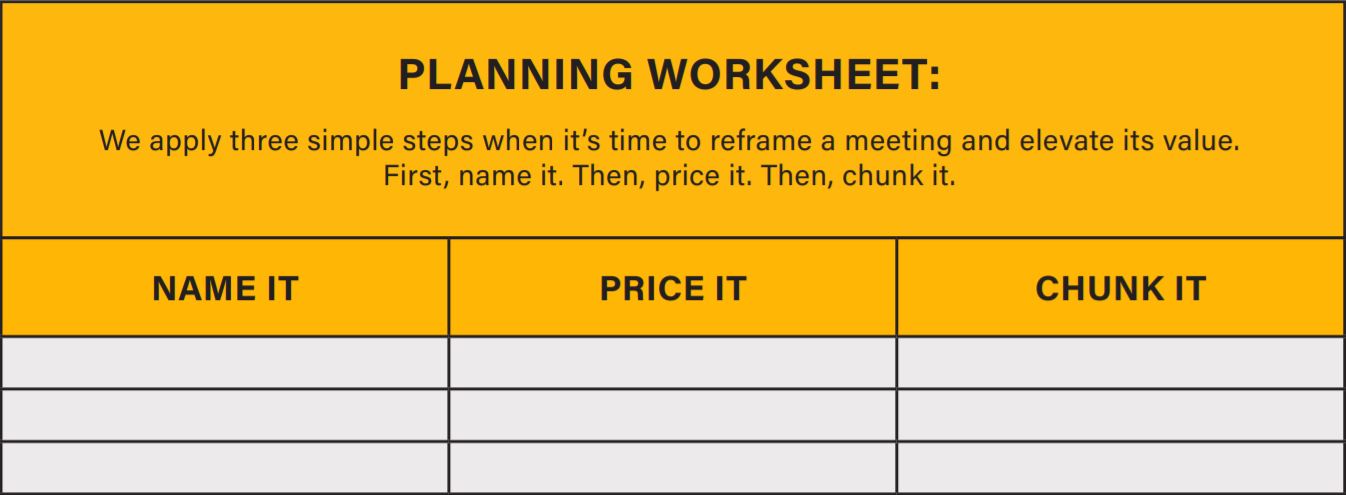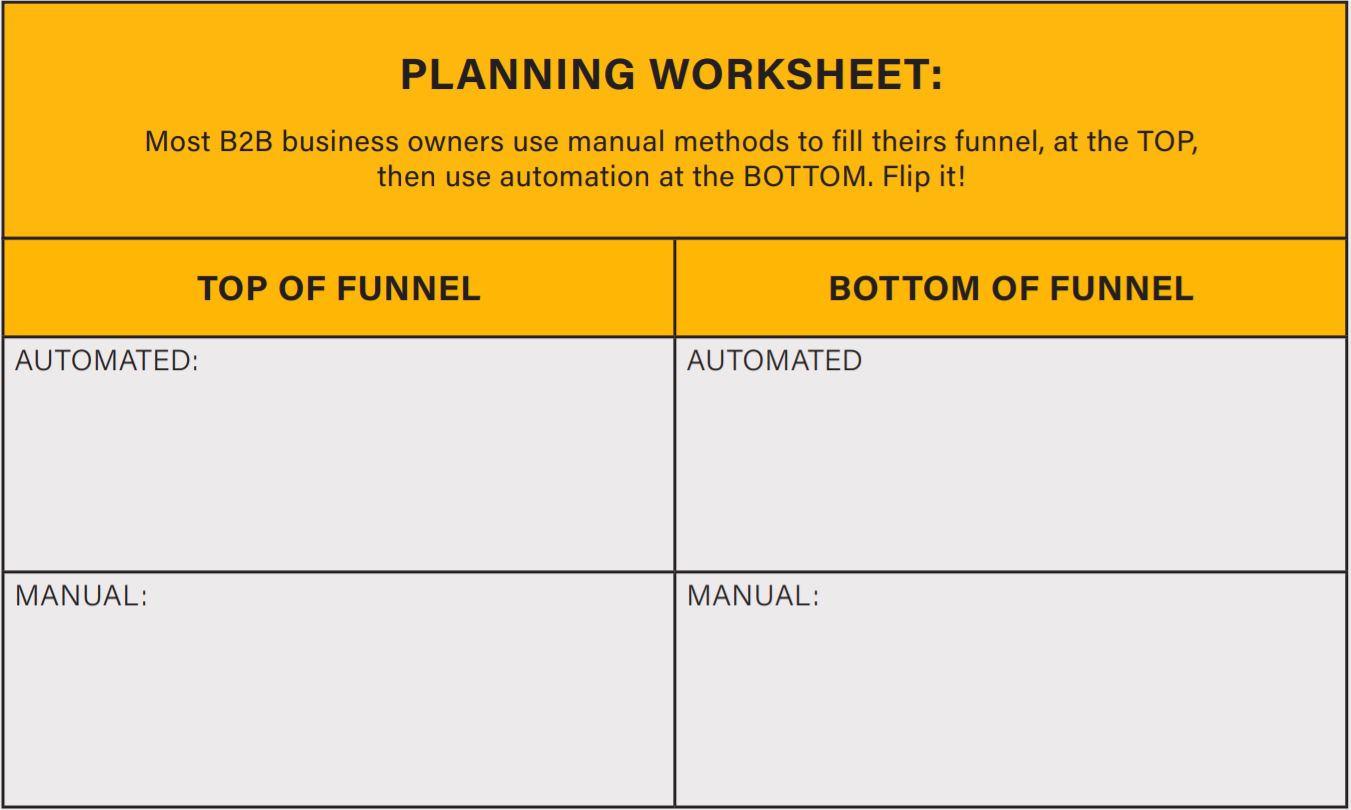Every B2B business needs a sales and marketing funnel, to capture leads, build trust, book meetings and close high-quality clients. Here’s how to do it in 10 steps over 10 days.
Click here to download the ‘Build Your First B2B Funnel’ as a helpful PDF guide.
Day 1: Metrics & Mapping 101
If you are selling a complex service or a big ticket product, every new client relationship will require multiple points of engagement. This has always been the case and it’s unlikely to change. How many ‘touches’ are required in your industry? A reliable baseline is seven. It might take less points of engagement or many more (to get that all important ‘commitment’, when a booking order is signed or a payment is made). Many of these ‘touches’ can be automated.
Indeed, it sometimes pays to prolong client contact, by giving prospects multiple opportunities to engage with you BEFORE you connect in a more meaningful way, for example, on the phone or meet face-to-face. In order to establish the most appropriate sequence of steps, it helps to start with the end in mind.
Do you know your U.O.T?
This stands for Ultimate Online Transaction. What is the final (or ultimate) transaction that’s likely to take place online? For example, if you have an e-commerce business, the final ‘transaction’ will most likely be an e-commerce sale. If you have a hospitality business, the final online ‘transaction’ might involve the download of a coupon, something that can be redeemed in-store. (In both those examples, the end goal is clear AND measurable, as two examples of online ‘transactions’.)
But what if you don’t sell anything online or you don’t run a physical ‘bricks and mortar’ business? If you sell knowledge or expertise, skill or ‘know how’ or a big-ticket product, just about every sale is likely to require some sort of conversation. And this typically happens offline.
If that’s the case, your end goal (your Ultimate Online Transaction) is likely to be a Meeting Request. We call these Inbound VIPs (i.e. Inbound ‘Very Interested Prospects’). And, if that’s you, you will need a way to track those bookings AND transform what’s normally an ‘ad hoc’ process (involving multiple calls and emails) into a measurable ‘Transaction’.
We use tools, like Calendly or ScheduleOnce, that show a limited number of pre-determined available slots. It then becomes the responsibility of the client to book the meeting. This minimizes the back and forth and prevents you from undermining your credibility as someone ‘in demand.’ Once you have an ‘end goal’ for the BOTTOM of the funnel, you can map out some basic metrics for each stage from BOTTOM to TOP, working backward (i.e. Conversion Rates).
ACTION: What is your end goal? How can you transform this goal into a measurable ‘transaction’ that happens ‘online’? How many times would you like that goal to happen every month? Or every week? Once you have measurable goals, you can begin to map out your own funnel, to reflect the steps (or ‘touches’) that need to take place in your industry.

Day 1 Goal: Set up a meeting booking tool to track UOTs. Use the worksheet to work back from that goal, setting basic benchmarks.
Day 2: Target & Topic
Most business operators think that they have a strong understanding of their target audiences. But, when you drill down a bit, the definition of most targeted audiences, for most owners, soon becomes ‘anyone who needs my product or service’.
But not all clients are created equal! Indeed, some are damaging to your business, and your soul!
Furthermore, the most effective forms of marketing are now ‘niche’. They focus on an extremely narrow target audience that self-identifies as that audience. For example, you might think that your marketing goal is to target ‘ambitious business leaders’. But that definition is subjective. Am I a leader? Are you a leader? Am I ambitious? Are you ambitious? It’s relative.
However, by targeting ‘CEOs of organisations with more than 20 staff who have held the roll for less than a year’ you have chosen an objective niche. There is no ambiguity here. Your audience will self-identify and say ‘that’s me’ or they will not.
If you can name your audience in a way that they understand, you will be more likely to grab their attention. If you can name them, it also becomes easier to find them. And it becomes easier for others to refer you work!
But, most importantly, if you can name them and find them, you can also figure out their headaches. And that’s the most important step for creating content, headlines and Lead Magnets that will draw them into your funnel and, therefore, into your world.
A Lead Magnet is an item of content designed to attract leads (like a magnet) and get an Opt-In (i.e. A basic lead, where the prospect provides permission to receive content, be marketed to or even approached by the seller). This strategy usually happens at the beginning or TOP of the funnel.
ACTION: Go narrow. Is there a segment within your various audiences that is easier to reach? Or more profitable? Or gets a better result than others? Or all of the above? What keeps this audience awake at night? What are their headaches, obstacles, aspirations and desires? That is the first step toward creating a headline for content (i.e. Topic) that can be used to grab attention and compel potential future clients to ‘Opt-In’ and receive your content and, therefore, enter your funnel.

Day 2 Goal: Identify an audience that passes the ‘Doctor on the Plane’ test. (This will be revealed in the training.) Draft a headline that acknowledges the headaches they have BEFORE they know they need you.
Day 3: Content & Cover
Have you heard of the 80/20 rule? The Pareto Principle? It applies to content creation too.
It doesn’t matter how carefully you research, craft, finesse and do what you need to do to make your Lead Magnet dazzle, if the topic doesn’t resonate with your target audience, the tool will fail to do its job (It won’t just fail to collect leads. It could also unintentionally alienate prospects.)
The best headlines promise to provide INSTRUCTION, not just opinions. For example, would you pay Tiger Woods money for his opinion on the PGA? No. But would you pay Tiger Woods to help you improve your drive? If you’re a golfer, for sure! You are unlikely to ever sell your Lead Magnet, but still try to think of it as a product that you could one-day sell.
The best headlines also offer to tackle a HEADACHE, and solve a real problem. The real problems shared by your target audience often might NOT involve you or your business, initially, at all. What are the headaches they have BEFORE they need you? A cold lead will have a problem. But they might not know that someone like you, with a business like yours, can solve it.
The cover is also important. This item of content will probably never be published. It won’t be sold in ‘all the best bookstores’. Indeed, only 40% of the people who download this free gift will actually read it! But it will need to look like a ‘thing’, which could be bought and kept on a shelf. This is one way to boost its perceived value and visually explain your intentions.
ACTION: What is a ‘How to’ headline that will get you started? If you can’t start your headline with the words ‘How to’, there’s a risk that you will ultimately produce an opinion piece. And what can you do to get your cover designed, as quickly as possible? This might seem back-to-front, but if you can get the cover designed while producing the content, you will accelerate the process AND give your online ambitions a big shot of motivation to get it finished and start promoting it.

Day 3 Goal: Devise a simple headline OR apply a ‘Content Shortcut’ and then take the first step toward getting your first Lead Magnet cover designed (or design it yourself ). We use design services that are super-affordable or suggest DIY design options, like Canva or even PPT.
Day 4: Buckets & Red Flags
As mentioned earlier, not all clients are created equal. Some are simply not worth your time or energy. But how will you ever know, in advance?
As part of any B2B funnel, we highly recommend the inclusion of a prequalifying, engagement-building, mind-reading Diagnostic or Checklist, usually sandwiched between an Opt-In page (featuring your Lead Magnet) and an offer to Book a meeting with you.
However, for the purposes of this 10 Day Challenge, we have combined two steps into one, merging the creation of an Opt-In Landing Page (promoting a Lead Magnet) with an online Diagnostic (to collect data and manage any necessary redirections).
A Diagnostic or Checklist is a Survey that promises to give something of value to the Lead (whereas a Survey usually just takes. It will ‘diagnose’ a problem or provide a list of actions or tools or tips.
Once again, this simple naming convention increases the perceived value. A Diagnosis, for example, is usually something you pay for, as can be a Checklist.
There are two essential ingredients to a highly effective pre-qualify Diagnostic or Checklist. It should segment your audiences into Buckets. (Remember, ‘One person. One problem. One product.’) And it should help you isolate time-wasters or inappropriate leads, so you can refer them elsewhere.
ACTION: If you could segment your ideal client types into three audiences, what would they be? For example, a business owner will need a different approach to a senior-level employee? A small business will have different needs to a big business? Also, what are the ‘red flags’? What factors tell you that a potential client might not be the right fit for you?

Day 4 Goal: Assemble your first lead generating, pre-qualifying Landing Page and Mini Diagnostic. Create eyeball-popping promo banner. For the Challenge, we use and recommend B2BDash, to create a combination Landing Page and Mini Diagnostic.
Day 5: Half Time RFA!
Momentum creates momentum! That’s why we incorporate RFA Challenges into all our training programs and courses. The letters ‘RFA’ stand for ‘Ready, Fire, Aim’ (and not ‘Ready, Aim, Fire) and that’s because far too many people spend far too much time aiming, aiming, aiming, and never fire.
That’s why, for DAY 5 of the Challenge, we encourage participants to ‘soft launch’ what they have assembled so far, either as a post on social media or as an email to their existing audiences. This will highlight gaps and accelerate your efforts to complete missing pieces. Ready, Fire! (Then, continue aiming, based on feedback from real people in the real world.)
Day 5 Goal: Add your banner to your Landing Page / Mini Diagnostic. Setup your desired redirect. Soft launch, via social media or email. (Then, pat yourself on the back for completing the first 5 days of the challenge!)
Day 6: Emails & Automation
Once somebody gives you a small sliver of their trust, by ‘opting-in’ to your offer and entering your funnel… Deliver on your promise!
That means, either redirect this potential, future client to a page where they can get the thing you promised. Or, if you intend to redirect that lead to a page with an invitation to book a meeting, make sure that the promised Lead Magnet (and/or results of your Diagnostic/Checklist) are sent to that person via email. Indeed, more advanced campaigns will usually involve a sequence of automated emails, designed to educate, inspire, answer questions and take the prospect on a journey.
ACTION: What are the sorts of questions that future clients ask again and again? What are some of the things that you would like prospects to know before you speak on the phone or meet face-to-face? What is your authentic connection to the problem you solve? Why are you passionate about what you do?

Day 6 Goal: Assemble and automate the first and most important email you will ever send. To do this, we recommend the ‘Campaigns’ feature of B2BDash.
Day 7: Appointments With Purpose
As you begin to fill your funnel, you will notice that ‘Meeting Bookings’ is usually the greatest bottleneck. While it’s now relatively easy to collect leads, compelling those people to set aside a small amount of their valuable time to meet with you (even over the phone) is getting harder and harder.
That’s because most people don’t ‘frame’ their meetings in the same way that they ‘frame’ their products and services. Indeed, you will notice that, during this Challenge, you will have already begun to think about ways to increase the perceived value of your Opt-In Gifts and Surveys, by thinking of them as ‘products’. The same should apply to meetings. Give them purpose, by framing them as a product. This will dramatically increase your meeting acceptance rate, even being automated funnels.
ACTION: What NAME could you give your meeting to emphasize its PURPOSE? What outcome will someone get from meeting with you? Could you attach a PRICE to your meetings? Even if you never intend to sell your meetings, this will re-frame how you think about meetings.

Day 7 Goal: Give your meetings a name. Reframe your appointments to have more purpose. Add your newly ‘framed’ appointment to your funnel.
Day 8: Beyond the Challenge
Modern sales and marketing is a very deep well. There is always more to learn. And there is only so much we can teach you or that you can achieve in 10 short days. (Even though, we’ve already covered a lot!)
This Challenge has been built from the premise that it’s better to have a basic funnel than no funnel at all (especially at this point in the evolution of technology, especially if you work in an industry that requires multiple touch-points before a sale).
But, in order to fully take advantage of the technologies and strategies available to a business like yours, there are some bigger picture concepts and trends worth being aware of. There are ways to ‘shortcut’ your ambitions to create ‘authority-building content, there are ways to amplify your profile and your ability to generate leads (and fill your funnel consistently), there are strategies that can be used to offset your marketing costs and productize your knowledge though the application of P4S products and ecosystems.
Day 8 Goal: That’s what DAY 8 is all about. It’s about helping you take full advantage of your progress during the 10 Day Challenge and helping you prioritize your goals and your ambitions beyond the Challenge.
Day 9: ‘Intelligent’ Outbound
If you are a typical business owner or sales professional, most of your sales and marketing efforts so far have been ‘outbound’, involving a combination of cold calling, cold email, networking and just pure hustle. You pick a target, chase and sometimes you get through the door.
Unfortunately, most forms of ‘outbound’ are not ‘intelligent’. They are ‘dumb’. They rely on hard work and luck. While persistence and hard-work are essential to success, some activities are an unnecessary grind. Life is short. Your time is precious. It’s time to get smart!
‘Intelligent’ Outbound can be used to generate leads. It can also be used to maximize the effectiveness of a funnel and ‘mop up’ potential opportunities that might otherwise have slipped through the cracks.
ACTION: How are you generating leads? What automated or digital options are becoming popular in your industry? What strategies could you borrow from other industries? How are you ‘dropping’ leads? What strategies do you have in place for leads that go cold or quality prospects that won’t seem to book time with you, using your tools?

Day 9 Goal: Start learning to embrace more efficient ways to engage with your audiences, in order to create a more positive experience for prospects, and save you time! Create a situation where they come to you!
Day 10: Review, Revisit & Ultimate RFA
There’s no point investing time and attention into the development of ANY marketing campaign… Unless you launch it!
Furthermore, the options to incorporate your funnel into your existing marketing activities and infrastructure are easily overlooked. This challenge is about reviewing and revisiting the lessons, before injecting your funnel into your existing activities in 10 different ways. That’s what it’s an ULTIMATE RFA.
ACTION: How could you incorporate a funnel into your existing marketing activities, right now? Do you have a website? Do you have a social media presence? Do you have a business card! There are many easy ways to start filing your funnel, already under your nose, before spending a cent.
That takes us to the end of the challenge! By now, you will have a fully functioning funnel to help you generate leads and clients- woohoo! The next part is to get people into your funnel. Attracting people to your funnel may seem like an impossible task, but the answer is usually right under our noses. If you’d like to find out how to find valuable people for your funnel, read our ‘Insanely Obvious Funnel Fillers‘ article by clicking here!
